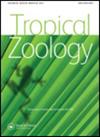尖吻阿曲形体的形态、发育和繁殖(Guérin-Méneville,1844)(直翅目:梨形目)
IF 0.4
4区 生物学
Q4 ZOOLOGY
引用次数: 0
摘要
为了更好地了解尖尖叶蚱的生物生态学并便于鉴定,我们在实验室条件下研究了尖叶蚱蜢在Manihot esculenta上的形态、发育和繁殖。在实验室中获得的551个第一若虫阶段被饲养在笼子里。一些身体部位可以清楚地识别不同的若虫龄。胚胎后发育经历了六个阶段(雄性)和七个阶段(雌性)。雄若虫1-5龄的平均若虫发育时间分别为17.14±0.62、12.91±0.62,13.45±0.69、13.80±0.68、15.23±0.55天,雌若虫1-6龄的平均发育时间分别是16.18±0.54、13.13±0.59、12.49±0.42、13.19±0.58、14.58±0.61、16.57±0.68天。成年雌性平均沉积3.67±2个卵荚,每个卵荚包含30.77±10.5个卵。第一次交配是在最后一次蜕皮后18±15.42天观察到的。第一次交配后平均19.33±5.33天产卵。这项研究提供了关于尖吻蚱蜢生物学的重要信息,有助于开发在喀麦隆南部防治这种蚱蜢的方法。本文章由计算机程序翻译,如有差异,请以英文原文为准。
Morphology, development and reproduction of Atractomorpha acutipennis (Guérin-Méneville, 1844) (Orthoptera: Pyrgomorphidae)
For a better knowledge of Atractomorpha acutipennis bio-ecology and to facilitate its identification, we studied the morphology, development and reproduction of this grasshopper on Manihot esculenta under laboratory conditions. Five hundred and fifty-one first nymphal stages obtained in the laboratory were reared in cages. Some body parts allowed a clear identification of different nymphal instars. Post-embryonic development passed through six stages (males) and seven stages (females). Mean nymphal development time was 17.14 ± 0.62, 12.91 ± 0.62, 13.45 ± 0.69, 13.80 ± 0.68, 15.23 ± 0.55 days respectively in males nymphal instars 1 to 5 and 16.18 ± 0.54, 13.13 ± 0.59, 12.49 ± 0.42, 13.19 ± 0.58, 14.58 ± 0.61, 16.57 ± 0.68 days respectively, in females nymphal instars 1 to 6. Adult females deposited an average of 3.67 ± 2 egg pods each comprising 30.77 ± 10.5 eggs. First mating was observed 18 ± 15.42 days after the last moult. Oviposition occured on average 19.33± 5.33 days after the first mating. This study provides important information about the biology of A. acutipennis, which could help in developing control methods against this grasshopper in southern Cameroon.
求助全文
通过发布文献求助,成功后即可免费获取论文全文。
去求助
来源期刊

Tropical Zoology
生物-动物学
CiteScore
2.50
自引率
0.00%
发文量
1
审稿时长
>12 weeks
期刊介绍:
Tropical Zoology is an international zoological journal publishing original papers in the field of systematics, biogeography, phylogeny, ecology and conservation of all terrestrial and aquatic animal Phyla from tropical and subtropical areas.
Only papers with new information, high quality and broad interest are considered. Single species description and checklists are not normally accepted. Review papers are welcome. The journal is owned by the Istituto di Ricerca sugli Ecosistemi Terrestri of the Consiglio Nazionale delle Ricerche, Florence, Italy (CNR-IRET) who performs research into the structure and functioning of aquatic and terrestrial ecosystems, focusing in particular on anthropogenic pressure and global change. The knowledge amassed forms the scientific basis for identifying the most appropriate protective and corrective interventions, and provides support for the bodies entrusted with formulating policies for environmental protection and recovery.
 求助内容:
求助内容: 应助结果提醒方式:
应助结果提醒方式:


